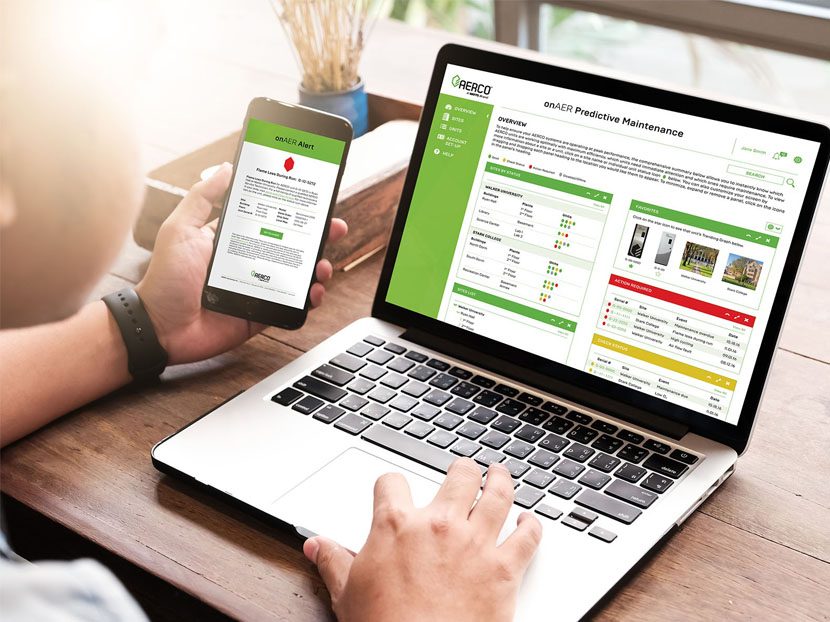Remote Monitoring Optimizes Heating Systems, Promotes Safety During Pandemic
Cloud-based data can also increase energy savings, reduce carbon footprint, and lower maintenance and operating costs

As the industry moves towards smart and connected heating products and systems, remote monitoring will become an increasingly important tool for building owners, facility managers, engineers and contractors in 2021. The ability to access and review boiler and water heater performance data remotely 24/7/365 is not only more efficient and convenient, it helps everyone who works with heating systems to remain safe during the continued threat of COVID-19.
A cloud-based remote monitoring solution allows data to be gathered in real time, analyzed, and then compared to historical data. Providing this level of examination optimizes system performance to create energy savings, allowing facilities to reduce their carbon footprint and meet established environmental goals. It also helps owners realize a return on investment in a shorter amount of time.
Keeping people safe
While everyone is hopeful that business operations will return to some sense of normalcy in 2021, it is apparent that will not be the case for the first few months of the year. A remote monitoring solution helps businesses adhere to established social distancing guidelines while still maximizing system performance.

A cloud-based remote monitoring solution allows experienced, skilled personnel to evaluate data safely from their offices.
If the data indicates a minor issue that can be corrected via remote operation, it can be fixed easily and promptly without entering the actual facility. This process saves a great deal of time and money and avoids an unnecessary trip.
For those issues that require on-site maintenance, remote monitoring allows a technician to review data and determine a maintenance plan of action prior to the visit.
Having this information beforehand allows technicians to arrive at the facility with the appropriate tools and parts. Without the need for multiple trips to the site to obtain the history and diagnose the problem, they can fix the issue more efficiently and enter and exit the building quickly. Technicians spend less time on-site, which promotes better safety and adherence to established protocols, while eliminating costly delays and return trips.
Advanced designs
Even when our “normal” day-to-day operations return, the benefits of remote monitoring go far beyond social distancing.
For years, boilers were integrated into a traditional building management system and would only receive about 10 critical application data points, as well as essential equipment statistics related to a boiler. Today’s boilers are more sophisticated, however, as they can have as many as 250 data points.
Due to this, considerably more analysis can be performed with a dedicated remote monitoring solution because it gathers and saves a full set of data points and built-in performance analytics.
A deeper level of detail gives building personnel a much stronger, more comprehensive understanding of a boiler or water heater system’s performance in real-time. Facility management is now capable of taking a predictive service approach to maintain system health and high performance, thus, increasing boiler and water heater efficiency while decreasing operational costs.
Optimizing performance
Remote monitoring conveniently sends alerts to inform facility managers of a fault or decline in heating and hot water system performance. Staff can, therefore, take early and immediate action to proactively resolve issues.

Any designated personnel can also access the data on an on-going basis for peace of mind. For example, effective remote monitoring systems also can connect facility personnel with authorized boiler or water heater manufacturers reps. Since these trained professionals also have access to the real-time data, they can locate the problem and give expert instruction to in-house staff to best correct the issue, and do so remotely to maintain social distancing protocols and help reduce downtime.
If a noncritical problem is observed through remote monitoring, it can be resolved more efficiently. Service is scheduled at the most convenient time to minimize disruptions to the facility and its occupants.
Remote monitoring also allows facility staff and trained technicians to review archived, historical data so they can analyze performance over time and recognize abnormal patterns to isolate problems.
Proactive, predictive maintenance can then be performed to prevent more serious and costly issues from occurring.
Energy-saving opportunities can also be identified through remote monitoring. With access to data, including efficiency, cycles per hour, O2 levels, and temperature, personnel can reduce unscheduled maintenance, and prevent unnecessary wear-and-tear on equipment, as well as premature failure. As a result, cost of ownership is significantly reduced.
In conclusion, remote monitoring is an essential tool for building owners, facility personnel and contractors.
It helps everyone stay safe in today’s social distancing environment. Additionally, system performance is optimized quickly and efficiently to increase energy savings, reduce carbon footprint, and lower maintenance and operating costs.
About the authors: Sarwat Siddique is a senior product manager, smart and connected solutions for AERCO. Nery Hernandez is a senior product manager, hydronic solutions for AERCO.




